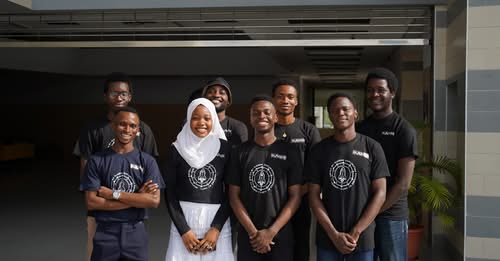In October, a Pan-Atlantic University (PAU) team developed Nigeria’s first Mars rover prototype, Trailblazer. The team secured second place at the African Rover Challenge, a competition showcasing engineering talent across the continent. They received a prize of ZAR 2,000 (USD 113.9).
The African Rover Challenge required participants to design and build a small, mobile Mars rover prototype. While not designed for actual Mars conditions, the prototype needed to demonstrate wireless control and an independent power source. The competition involved two primary stages: a launch stage and a Mars simulation stage.
Space in Africa interviewed the Pan-Atlantic University team to explore the details of their Trailblazer project and the team’s future objectives.
What inspired the attempt to take on the challenge of building the robot probe?
When we discovered the invite-only theme for the African robotics competition, we recognised this was the inaugural event of its kind. Since previous competitions had been ongoing for years, we saw a unique opportunity to showcase our skills, enthusiasm, and talent. Moreover, our motivation extended beyond personal achievement. We wanted to create something that would inspire younger generations and, most importantly, represent Nigeria internationally.
Can you walk me through the initial stages of conceptualisation? What happened before you started working on the project?
When we first saw the call for entry, we submitted our application and were subsequently selected to participate. The initial conceptualisation phase began with a comprehensive exploration of potential innovation areas. We conducted extensive meetings at the electrical park, engaging in collaborative brainstorming sessions. Our aim was to develop something unique – not simply replicating existing approaches but creating an innovative solution.
We approached the challenge strategically, focusing on green technology thinking and practical problem-solving. Our team discussed various concepts, synthesising our collective expertise to develop a novel approach. Through this iterative process of creativity and refinement, we gradually shaped the project’s core features and vision.
What were the main technical challenges you faced during the project?
When our team embarked on the robot probe project, we encountered several significant technical challenges that tested our engineering skills and collaborative capabilities. The first major hurdle emerged during the initial material selection phase. We needed to find lightweight materials to effectively support the probe’s expected payload while managing cost constraints and ensuring market availability. This delicate balancing act required meticulous research and strategic decision-making to guarantee our design’s structural integrity and overall feasibility. Electrical system design and sensor integration proved equally complex. We grappled with intricate technical issues surrounding sensor compatibility, voltage management across diverse components, and ensuring consistent power supply for sensors with varying electrical requirements. Each sensor demanded specific voltage levels, creating a challenging electrical engineering puzzle that required innovative solutions and careful integration.
Our team’s composition added another layer of complexity. Composed of 14 students from mechanical engineering, electrical engineering, and other disciplines, we brought diverse perspectives and skills. While this diversity was ultimately a strength, it initially presented challenges in creating a cohesive technical approach. We had to bridge knowledge gaps, conduct extensive research to understand advanced functionalities, and rapidly learn new technologies, particularly in emerging areas like AI capabilities and robotic movement. Geographic dispersion compounded our challenges. With team members scattered across Nigeria, we developed creative collaboration strategies. This often meant conducting in-person meetings at team members’ homes, overcoming the limitations of online collaboration, and developing robust communication mechanisms to maintain project momentum. These challenges demanded more than just technical expertise. They required creative problem-solving, adaptability, and an unwavering commitment to collaborative learning.
How were you able to mitigate the challenges you mentioned earlier, particularly with sensor integration and material selection?
When addressing our technical challenges, we developed strategic approaches to mitigate each obstacle. For material selection, we conducted comprehensive market research to identify the optimal materials for our project. We ultimately chose a combination of acrylic and aluminium sheets, which allowed us to achieve several critical objectives. These materials provided lightweight characteristics while maintaining structural integrity and offered excellent aesthetic value and manufacturability. Additionally, aluminium sheets were readily available in local markets, solving our cost and accessibility concerns. We adopted a modular approach based on advice from experienced faculty and senior students regarding component integration. Our strategy was to treat each component as a standalone module with its specific design and functionality. This approach allowed us to develop and optimise each part separately before integrating them into a cohesive system. We could systematically address wiring, connections, and overall aesthetic design by breaking down the complex system into manageable modules—including the battery pack, design units, and various sensors.
We consulted with our project supervisors and lecturers who had similar project experience. Their guidance was instrumental in helping us navigate the intricate process of sensor and component integration. The modular methodology enabled us to troubleshoot individual components more effectively and ultimately create a more robust and reliable final product. This systematic approach helped us overcome technical challenges and ensured our final design was functional and visually appealing.
Can you explain your robot probe’s power source and wireless control system?
When developing our power system, we prioritised sustainability and reliability. We selected a robust battery capable of continuously powering all onboard systems for three to four hours. This included providing energy for antennas, controllers, and various integrated components simultaneously. Our power strategy incorporated renewable energy considerations, focusing on green technology principles. We implemented a battery management system to monitor battery life and ensure efficient power usage. We were particularly mindful of creating a sustainable power solution that could be recharged and maintained effectively.
For the wireless control system, we established specific range requirements. The minimum requirement was to achieve a control distance of approximately 100 metres. We extended this range to around 400 meters using a repurposed RC car controller through iterative design and testing. We studied and adapted control mechanisms from remote-controlled systems, such as remote-controlled cars, to inform our design. The wireless control architecture involved connecting multiple modules (Arduino Uno and ESP32 modules), allowing operators to manage the robot probe from significant distances. Our design ensured reliable communication between the control unit and the robot’s various systems, enabling precise and responsive remote operation.
What are the unique features that make your rover innovative and distinctive?
Our rover incorporates several groundbreaking features that set it apart from traditional planetary exploration vehicles. We developed a sophisticated suspension system that combines the adaptability of rover designs with advanced damping technology typically used in heavy vehicles. This hybrid suspension allows our rover to navigate extremely challenging terrains with remarkable stability and precision. One of our most distinctive design elements is an integrated launching mechanism inspired by satellite deployment technologies. The rover can launch a payload with a Nigerian flag to a substantial altitude, with the ability to deploy a parachute for controlled descent. This feature was conceptualised with potential Mars exploration scenarios in mind, considering the planet’s unique atmospheric conditions and the challenges of long-distance scientific missions.
A critical innovation is the sample collection and analysis system. The rover features a specialised scoop at its front, which is capable of collecting ground samples. Accompanying test cubes allows for immediate on-site sample preservation and preliminary analysis. This design enables scientists to collect, store, and prepare samples for more detailed examination, on-site or later in the mission. The image analysis station represents another technological breakthrough. We integrated a pre-trained artificial intelligence system capable of analysing rover-captured images of rock samples. The AI can:
- Identify rock types
- Determine water content
- Assess the potential habitability of the sampled area
Perhaps most innovatively, our survivability assessment feature creates a detailed probability grid. By analysing rock sample data, the system can map areas with historical water retention, helping scientists identify potential past or present habitable zones. This grid provides crucial insights for future Mars exploration, highlighting regions most likely to support or have supported life.
What are your plans for the rover beyond the competition?
Our vision extends far beyond the competition. We plan to transform our rover into a commercially viable, multi-purpose technological solution. We aim to develop a versatile base model that can be customised for various industries, creating a scalable platform with applications in space exploration and terrestrial industries.
In the agricultural sector, for instance, we see immense potential. The rover could be adapted to provide farmers with comprehensive soil analysis capabilities. Farmers could receive detailed insights about mineral content, nutrient levels, and potential soil improvements by collecting soil samples and utilising our advanced AI-driven analysis system. This would enable precision agriculture, allowing farmers to make data-driven soil management, crop health, and productivity decisions. Our business model is inspired by the automotive industry’s approach to customisation. We’re developing a fundamental base model that can be modified to meet specific industry requirements. This modular design allows for tailored adaptations across multiple sectors:
- Agricultural soil analysis
- Mining and resource exploration
- Oil and gas industry surveying
- Environmental monitoring
- Disaster response and terrain assessment
The core innovation lies in creating a flexible platform that can be reconfigured for different use cases while maintaining a consistent technological foundation. Each industry could request specific modifications, creating a custom solution built upon our core rover technology. Ultimately, we aim to demonstrate that cutting-edge technology developed in Nigeria can be globally competitive and locally transformative. We’re not just building a rover but creating a technological ecosystem that can drive innovation across multiple industries, showcasing the potential of Nigerian engineering and technological expertise.
Source: https://spaceinafrica.com/2024/12/09/innovation-on-wheels-inside-nigerias-first-mars-rover-prototype/



